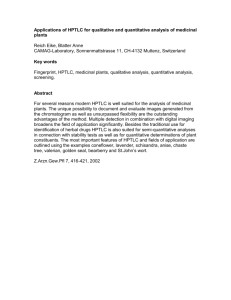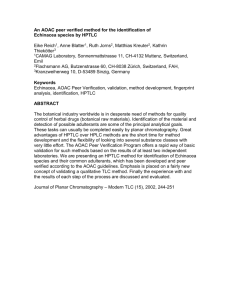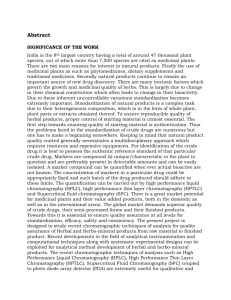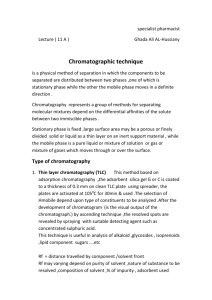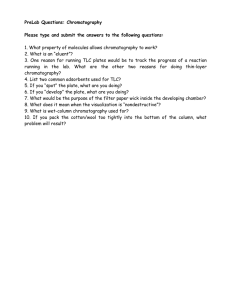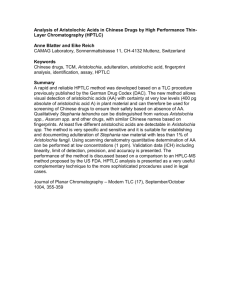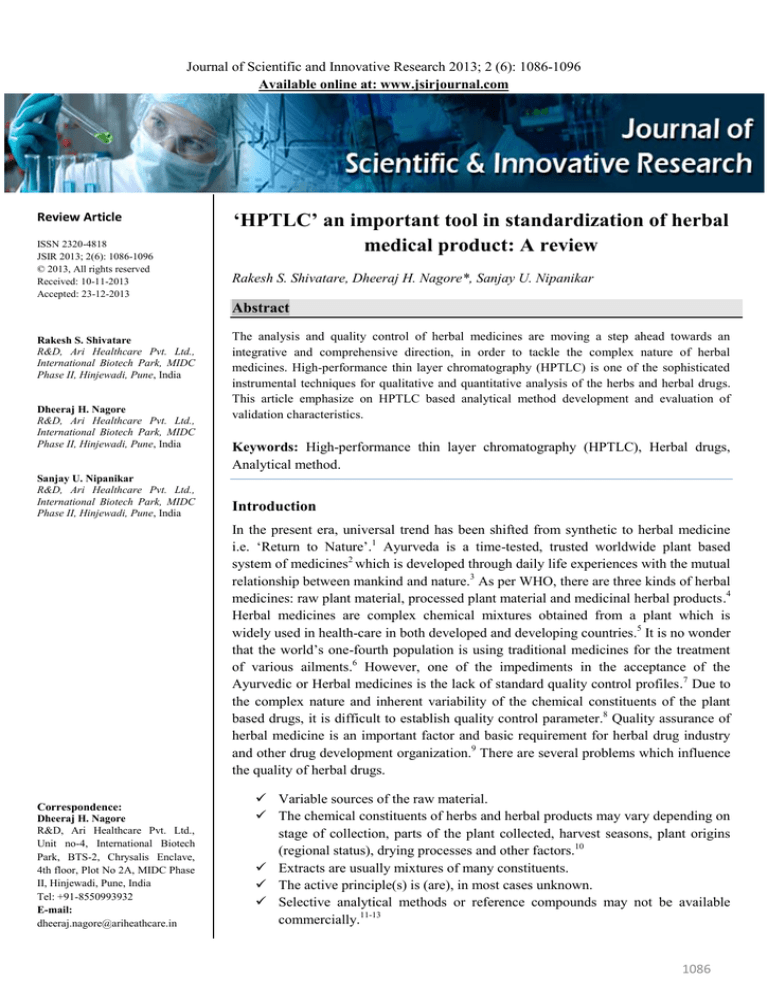
Journal of Scientific and Innovative Research 2013; 2 (6): 1086-1096
Available online at: www.jsirjournal.com
Review Article
ISSN 2320-4818
JSIR 2013; 2(6): 1086-1096
© 2013, All rights reserved
Received: 10-11-2013
Accepted: 23-12-2013
‘HPTLC’ an important tool in standardization of herbal
medical product: A review
Rakesh S. Shivatare, Dheeraj H. Nagore*, Sanjay U. Nipanikar
Abstract
Rakesh S. Shivatare
R&D, Ari Healthcare Pvt. Ltd.,
International Biotech Park, MIDC
Phase II, Hinjewadi, Pune, India
Dheeraj H. Nagore
R&D, Ari Healthcare Pvt. Ltd.,
International Biotech Park, MIDC
Phase II, Hinjewadi, Pune, India
Sanjay U. Nipanikar
R&D, Ari Healthcare Pvt. Ltd.,
International Biotech Park, MIDC
Phase II, Hinjewadi, Pune, India
The analysis and quality control of herbal medicines are moving a step ahead towards an
integrative and comprehensive direction, in order to tackle the complex nature of herbal
medicines. High-performance thin layer chromatography (HPTLC) is one of the sophisticated
instrumental techniques for qualitative and quantitative analysis of the herbs and herbal drugs.
This article emphasize on HPTLC based analytical method development and evaluation of
validation characteristics.
Keywords: High-performance thin layer chromatography (HPTLC), Herbal drugs,
Analytical method.
Introduction
In the present era, universal trend has been shifted from synthetic to herbal medicine
i.e. „Return to Nature‟.1 Ayurveda is a time-tested, trusted worldwide plant based
system of medicines2 which is developed through daily life experiences with the mutual
relationship between mankind and nature.3 As per WHO, there are three kinds of herbal
medicines: raw plant material, processed plant material and medicinal herbal products.4
Herbal medicines are complex chemical mixtures obtained from a plant which is
widely used in health-care in both developed and developing countries.5 It is no wonder
that the world‟s one-fourth population is using traditional medicines for the treatment
of various ailments.6 However, one of the impediments in the acceptance of the
Ayurvedic or Herbal medicines is the lack of standard quality control profiles.7 Due to
the complex nature and inherent variability of the chemical constituents of the plant
based drugs, it is difficult to establish quality control parameter.8 Quality assurance of
herbal medicine is an important factor and basic requirement for herbal drug industry
and other drug development organization.9 There are several problems which influence
the quality of herbal drugs.
Correspondence:
Dheeraj H. Nagore
R&D, Ari Healthcare Pvt. Ltd.,
Unit no-4, International Biotech
Park, BTS-2, Chrysalis Enclave,
4th floor, Plot No 2A, MIDC Phase
II, Hinjewadi, Pune, India
Tel: +91-8550993932
E-mail:
dheeraj.nagore@ariheathcare.in
Variable sources of the raw material.
The chemical constituents of herbs and herbal products may vary depending on
stage of collection, parts of the plant collected, harvest seasons, plant origins
(regional status), drying processes and other factors.10
Extracts are usually mixtures of many constituents.
The active principle(s) is (are), in most cases unknown.
Selective analytical methods or reference compounds may not be available
commercially.11-13
1086
Journal of Scientific and Innovative Research
All pharmacopoeias set standards for the quality, purity,
strength, and consistency of these products–critical to the
public health. USP–NF contains approximately 4500
monographs for drug substances, dosage forms, excipients
and other therapeutics. Today, USP proposes the first 23
ingredients to be included in the new Herbal Medicines
Compendium (HMC).14 The IP 2007, which was made
effective from last July, has already over 1600
monographs.15 The British Pharmacopoeia 2012 contains
approximately 3375 monographs for substances,
preparations and articles used in the practice of medicine.16
Standardization is an important step for the establishment
of a consistent biological activity, a consistent chemical
profile, or simply a quality assurance program for
production and USP manufacturing of an herbal drug.17 It
is the process of developing and agreeing upon technical
standards. Specific standards are worked out by
experimentation and observations, which would lead to the
process of prescribing a set of characteristics exhibited by
the particular herbal medicine. Hence standardization is a
tool in the quality control process.18
Figure 1: A schematic representation of standardization of herbal drugs
HPTLC is a modern adaptation of TLC with better and advanced separation efficiency and detection limits. The table 1
compares HPTLC and TLC.19-28
Table 1: Difference between TLC and HPTLC
PARAMETER
Technique
Efficiency
Layer
Mean particle size
Layer Thickness
Plate Height
Solid Support
Sample Spotting
TLC
Manual
Less
Lab Made/ Pre-Coated
10-12 um
250 um
30 um
Silica
Gel,
Alumina,
Kiesulguhr
Manual Spotting (Capillary/
HPTLC
Instrumental
High (Due to smaller particle size)
Pre-coated
5-6 um
100 um
12 um
Silica Gel- Normal Phase
C8 and C18- Reverse phase
Auto sampler (Syringe)
1087
Journal of Scientific and Innovative Research
Sample Volume
Pipette)
1-5 ul
0.1-0.5 ul
Shape of Sample
Circular (2-4 nm Dia)
Rectangular (6 mm L × 1mm W)
Separation
10-15 cm
3-5 cm
Separation Time
20-200 Min
3-20 Min
Sample tracks per plate
≤ 10
≤ 36 (72)
Detection Limits (Absorption)
1-5 pg
100-500 pg
Detection limits
(Fluorescence)
50-100 pg
5-10 pg
PC connectivity,
Method Storage
No
Yes
Validation,
Quantitative
Analysis, Spectrum Analysis
No
Yes
Analysis Time
Slower
Shortage Migration Distance and the analysis time is
greatly reduced
Wavelength Range
254 or 366 nm, Visible
190 or 800 nm, Monochromatic
Scanning
Not possible
Use of UV/ visible/ fluorescence scanner scans the
entire chromatogram qualitatively and quantitatively
and scanner is an advanced type of Densitometer
There are several advantages of using HPTLC for the
analysis of compounds as compared to other techniques,
like HPLC, spectrophotometry, titrimetry, etc.26 Some of
the advantages of HPTLC are:
Ability to analyze crude samples containing multicomponents.
The separation process is easy to follow especially
with colored compounds.
Several samples can be separated parallel to each
other on the same plate resulting in a high output,
time saving, and a rapid low-cost analysis.
Choice of solvents for the HPTLC development is
wide as the mobile phases are fully evaporated
before the detection step.
Two-dimensional separations are easy to perform.
Stability during chromatography should be tested
using two-dimensional development.28
Specific and sensitive colour reagents can be used
to
detect
separated
spots
(Dragendroff
29
reagent/Kedde reagent).
HPTLC can combine and consequently be used for
different modes of evaluation, allowing
identification of compounds having different lightabsorption characteristics or different colours.
Contact detection allows radiolabelled compounds
to be monitored and microbial activity in spots to
be assessed.
HPTLC method may help to minimizes exposure
risk of toxic organic effluents and significantly
reduces its disposal problems, consequently,
reducing environment pollution.21-31
Classification of HPTLC
HPTLC techniques may be classified into four classes i.e.
Classical, High performance, Ultra and Preparative thinlayer chromatography. They differ with classical TLC in
the particle size distribution and thickness of the sorbent
layers. The mean particles sizes are 12, 5, 25 µm for
classical, high-performance and preparative thin-layer
chromatography, respectively, whereas Ultra thin layer
chromatography does not have particles but a monolithic
layer with 1–2 um macropores.32 Another difference is the
thickness of the sorbent layers which is 250 um, 200 um,
10 um and 0.5–2 mm, for classical, high-performance,
ultra-thin and preparative sorbent layers, respectively.21
1088
Journal of Scientific and Innovative Research
Figure 2: Classification of HPTLC techniques
Common Methodology for HPTLC Analysis
Method
development
in
thin-layer
(planar)
chromatography is one of the most significant steps for a
qualitative and quantitative analysis. During establishing a
new analytical procedure, always starts with wide literature
survey33
i.e.
primary
information
about
the
physicochemical characteristics of sample and nature of
the sample (structure, polarity, volatility, stability and
solubility). It involves considerable trial and error
procedures.34 General steps involved in HPTLC method
developments are as follow: 23, 35
Basic Steps:
Selection of the stationary phase
Mobile phase selection and optimization
Sample Preparation and Application
Chromatogram Development (separation)
Detection
Range
Accuracy
Precision
Detection Limit, Quantitation Limit
Robustness
Basic Steps:
Selection of the stationary phaseDuring method development, stationary phase selection
should be based on the type of compounds to be
separated.36 HPTLC uses smaller plates (10*10 or 10*20
cm) with significantly decreased development distance
(typically 6 cm) and analysis time (7–20 min). HPTLC
plates provide improved resolution, higher detection
sensitivity, and improved in situ quantification and are
used for industrial pharmaceutical densitometric
quantitative analysis.31, 37
Mobile phase selection and optimization-
Quantitation:
HPTLC method
analysis:
validation
for
pharmaceutical
Specificity
Linearity
The selection of mobile phase is based on adsorbent
material used as stationary phase and physical and
chemical properties of analyte. 28, 29 The Table 2 gives the
details of mobile phase generally used in detection of some
chemical compounds.
Table 2: Generally used Mobile phase in detection of some chemical compounds
SN
1
2
Chemical Compounds
Polar Compounds
Anthraglycosides, Arbutin, Alkaloids, Cardiac
Glycosides, Bitter Principles, Flavonoids,
Saponin
Lipophilic Compounds
Mobile Phase
Ethyl Acetate: Methanol: Water [100:13.5:10]
Toluene: Ethyl Acetate [93:7]
1089
Journal of Scientific and Innovative Research
3
4
Essential
oils,
Terpenes,
Napthoquinons, Velpotriate
Alkaloids
Flavonoids
5
Saponin
6
Coumarin
7
8
Bitter Drug
Cardiac Glycosides
9
Essential Oil
10
Lignans
11
Pigments
12
13
Pungent Testing
Terpenes
14
Triterpenes
Coumarin,
Toluene: Ethyl Acetate: Diethyl Amine [70:20:10]
Ethyl Acetate: Formic Acid: Glacial Acetic Acid: Water
[100:11:11:26]
Chloroform: Glacial Acetic Acid: Methanol: Water
[64:32:12:8]
Diethyl Ether: Toluene
[1:1] Saturated with 10% Acetic Acid
Ethyl Acetate: Methanol: Water [77:15:8]
Ethyl Acetate: Methanol: Water
[100:13.5:10] OR [81:11:8]
Toluene: Ethyl Acetate
[93:7]
Chloroform: Methanol: Water [70:30:4]
Chloroform: Methanol [90:10]
Toluene: Ethyl Acetate [70:30]
Ethyl Acetate: Formic Acid: Glacial Acetic Acid: Water
[100:11:11:26]
Toluene: Ethyl Acetate [70:30]
Chloroform: Methanol: Water
[65:25:4]
Ethyl Acetate: Toluene: Formic Acid [50:50:15]
Toluene: Chloroform: Ethanol [40:40:10]
is related to the polarity of the mobile phase components.23
The more nonpolar the compound, the faster it will elute
(or the less time it will remain on the stationary phase) and
the more polar the compound the slower it will elute (or
more time on the stationary phase). The following chart is
helpful in predicting the order of elution.21, 28
Sample Preparation and Application-
A good solvent system is one that moves all components of
the mixture off the baseline, but does not put anything on
the solvent front. The peaks of interest should be resolved
between Rf 0.15 and 0.85. The elution power of the mobile
phase depends on a property called eluent strength which
Table 3: Common Mobile Phases listed by Increasing Polarity
Eluent Strength
0.00
2
Hexane
0.01
3
Cyclohexane
0.04
4
Carbon tetrachloride
0.18
5
Toluene
0.29
6
Chloroform
0.40
7
Methylene Chloride
0.42
8
Tetrahydrofuran
0.45
9
Acetone
0.56
10
Ethyl Acetate
0.58
11
Aniline
0.62
12
Acetonitrile
0.65
13
Ethanol
0.88
14
Methanol
0.95
15
Acetic Acid
Large
polar functional groups
Solvent
N- Pentane
Increasing polarity and ‘Solvent Power’ toward
S. No
1
1090
Journal of Scientific and Innovative Research
Pharmaceutical preparation with sufficiently high
concentration of analyte is simply dissolved in a suitable
solvent that will completely solubilize the analyte and
leave excipients undissolved to yield a test solution that
can be directly applied on HPTLC plate.34, 38 It is a fact that
application of the sample is the most critical step to obtain
good resolution for quantification in HPTLC21.Sample
application technique depends on factors such as the type
of sample matrix, workload and time constraints.39,23
indicator is excited with UV wavelength at 254 nm and
emits green fluorescence.43 Compounds that absorb
radiation at 254 nm reduce this emission on the layer, and
a dark violet spot on a green background is observed where
the compound zones are located.23, 44 This quenching is
caused by all compounds with conjugated double bonds.
Anthraglycosides, coumarins, flavonoids, propylphenols in
essential oils, some alkaloid type such as indole,
isoquinoline and quinoline alkaloids etc. should be
detected under 254 nm. 29, 45
Chromatogram Development (separation)Although chromatogram development is the most crucial
step in the HTLC procedure, important parameters are
generally overlooked.28 HPTLC plates are developed in
twin-trough
chambers,
or
horizontal-development
chambers. In general, saturated twin-trough chambers
fitted with filter paper offer the best reproducibility. Twinthrough chamber avoids solvent vapor preloading and
humidity.40-42
Visualization at UV 366 nm
F 366 should be described as Fluorescence quenching. In
this instance the fluorescence does not remains after the
source of excitation is removed.42 This quenching is shown
by all anthraglycosides, coumarins, flavonoids,
Phenolcarboxylic acids, some alkaloid types (Rauwolfia,
Ipecacuanha alkaloids).29
Visualization at white light
DetectionDetection of separated compounds on the sorbent layers is
enhanced by quenching of fluorescence due to UV light
(ranged normally at 200-400 nm). This process is
commonly called Fluorescence quenching.
Visualization at UV 254 nm
F254 should be described as phosphorescence quenching.
In this instance the fluorescence remains for a short period
after the source of excitation is removed. It is very short
lived, but longer than 10 seconds.42 F254 fluorescent
Zone containing separated compounds can be detected by
viewing their natural color in daylight (White light).37
Derivatisation
Derivatization can be defined as a procedural technique
that primarily modifies an analyte‟s functionality in order
to enable chromatographic separations. Derivatization can
be performed either by immersing the plates or by spraying
the plates with a suitable reagent (Table 4). 28,29,46,47 For
better reproducibility, immersion is the preferred
derivatization technique.
Table 4: List of common derivatization reagents
SN
1
2
3
Colour Reagent
Dragendroff Reagent
It forms complex reaction with
some
nitrogen
containing
compounds
Natural productsPolyethylene Glycol reagent i.e.
Diphenylboric acid -2-aminoethyl
ester forms complexes with 3hydroxyflavones via condensation
reaction
Vanillin Sulphuric Acid OR
Anisaldehyde Sulphuric Acid
Chemical Compounds
Alkaloids
Colour
Red-brown Zone (vis)
Flavonoids
Intense yellow, Orange and
Fluorescent zones in UV 366 nm
Bitter Principle
Red-brown, Yellow-brown, Dark green Zone
(vis)
Coloured zones (vis)
Blue, brown or red zones (vis)
Saponin
Essential Oil
Green
1091
Journal of Scientific and Innovative Research
4
10 % Ethanolic KOH
5
Ninhydrin Reagent
6
Iodine
It produce iodine reaction possibly
result in an oxidative products
Anthraquinones
(Emodin, Rhein)
Anthrones
(Aloin, Cascarosides)
Coumarins,
Scopoletin,
Umbelliferone
Amino acids, peptides,
amines and amino-sugars
Indole,
quinoline
derivative, thiols and all
organic compounds
Yellow, brown to pink and violet (vis)
Dark zone (UV 254)
degradants, matrix, etc. It includes Identification, Purity
tests and Assy.48
Quantitation:
Generally quantitative evaluation is performed by
measuring the zones of samples and standards using a
densitometer or scanner with a fixed sample light beam in
the form of a rectangular slit. The chromatogram can be
scanned in reflectance or in transmittance mode by
absorbance or by fluorescent mode; scanning speed is used
up to 100 mm/s.23,28 Due to scanning spectra calibration of
single and multiple levels of linearity, linear and nonlinear
regression equations are possible. Scanning has been done
by two methods i.e. Slit Scanning and Video Scanning.21
Slit ScanningSlit-scanning densitometry is now relatively mature and
although limited to absorption and fluorescence detection
in the UV–visible range. It consists of fiber optic bundle
for illumination of sample zones and collection of reflected
light (or fluorescence). Photodiode-array detector is used
for simultaneous length detection and spectral recording.28
Video ScanningVideo densitometry is fast and simultaneous data
acquisition from the whole plate. In which optical scanning
takes place electronically, using a computer with video
digitizer, light source, monochromators, and appropriate
optics to illuminate the plate and focus the image onto a
charge-coupled device (CCD) video camera. It is also
useful in two-dimensional separations for thin-layer
chromatography with image analysis.28
HPTLC method
analysis:
Red zones (vis)
Red Fluorescence (UV 366 nm)
Yellow zones (vis)
Yellow Fluorescence (UV 366 nm)
Bright blue Fluorescent zone (UV 366 nm)
validation
for
pharmaceutical
SpecificitySpecificity is the ability to assess unequivocally the analyte
in the presence of components which may be expected to
be present. Typically these might include impurities,
The specificity of the method was ascertained by analyzing
standard drug and sample. The peak purity of chemical
compound was assessed by comparing the spectra at three
different levels, i.e., peak start (S), peak apex (M), and
peak end (E) positions of the spot.28
LinearityThe linearity of an analytical procedure is its ability
(within a given range) to obtain test results which are
directly proportional to the concentration (amount) of
analyte in the sample.48 The linearity is usually
documented as the ordinary least squares (OLS) curve or
simply as linear regression curve of the measured
responses (peak area or height) as a function of increasing
analyte concentrations.49
RangeThe range of an analytical procedure is the interval
between the upper and lower concentration (amounts) of
analyte in the sample (including these concentrations) for
which it has been demonstrated that the analytical
procedure has a suitable level of precision, accuracy and
linearity.48 In the Pharmaceutical Industry usually a range
from 80 to 120% of the target concentrations was tested.17
AccuracyThe accuracy of an analytical procedure expresses the
closeness of agreement between the value which is
accepted either as a conventional true value or an accepted
reference value and the value found.48 For bio-analytical
method, accuracy should be performed for at least three
quality control (QC) samples (low, medium, and high) in
triplicate, and the accuracy was expressed as % recovery.50
Precision1092
Journal of Scientific and Innovative Research
Precision of the analytical method can be divided into
three categories, i.e., repeatability, intermediate precision,
and reproducibility. Repeatability, or intraassay within-day
precision, is determined when the analysis is done in one
laboratory by one analyst with same conditions
(equipment, TLC plate, reagents) and performed within 1
day work. Intermediate precision is obtained when the
analysis was performed within a laboratory by different
analysts, equipment, reagents, and plates over a number of
days or weeks. Reproducibility represents the precision
obtained from some laboratories with the aim to verify
whether the method can yield the same results in different
laboratories.48, 51
(chromatographic) analytical methods can be defined in
terms of the signal-to-noise ratio (2:1–3:1 for DL and 10:1
for QL) or in terms of the ratio of the standard deviation of
the blank response, the residual standard deviation of the
calibration line, or the standard deviation of intercept (s)
and slope (S) can be used. 54, 55
Robustness-
For bioanalytical method, it is recommended to test the
precision using a minimum of five determinations per
concentration. A minimum of three levels of
concentrations in the expected range is recommended;
RSD is not permitted more than 15%, and at the maximum
limit, lower concentration RSD of 20% is acceptable. 52, 53
The robustness of an analytical procedure is a measure of
its capacity to remain unaffected by small, but deliberate
variations in method parameters and provides an indication
of its reliability during normal usage.48 Some important
parameters for testing of the robustness evaluation for
HPTLC methods are mobile phase composition, pH of the
mobile phase, temperature, development distance, spot
shape, spot size, batch of the plates, volume of samples,
drying condition (temperature, time) and condition of spot
visualization (spraying reagents, dipping reagents, UV
detection).56
Detection Limit, Quantitation Limit-
HPTLC vs. HPLC
The detection limit of an individual analytical procedure is
the lowest amount of analyte in a sample which can be
detected but not necessarily quantitated as an exact value.
The quantitation limit (QL) of an individual analytical
procedure is the lowest amount of analyte in a sample
which can be quantitatively determined with suitable
precision and accuracy48. Generally, QL can be estimated
as 2–3 times of DL. DL and QL for instrumental
High-performance thin-layer chromatography (HPTLC) is
still increasingly finding its way in pharmaceutical analysis
in some parts of the world. With the advancements in the
stationary phases and the introduction of densitometers as
detection equipment, the technique achieves for given
applications a precision and trueness comparable to highperformance liquid chromatography (HPLC). Basic
differences between HPLC and HPTLC are given in
following table 5.28, 57, 58
Table 5: Differences between HPLC and HPTLC
Parameters
Type
Stationary phase
Conditioning phase
Separation by
Results
Analysis
Resolution
Chromatography System
Separating medium
Strongly Retarded
Fractions Seen As
Analysis in parallel
High temp. / pressure
Time per sample
Data
obtained
chromatography
from
HPLC
Reverse Phase Chromagraphy
Liquid
None
Partition
By machine
On ‐ line
Very high
Closed
Tubular column
Broad peaks
HPTLC
Straight Phase Chromagraphy
Solid
Gas
Adsorption
By machine + eyes
Off ‐ line
Moderate to high
Open
Planar layer (plate)
Sharp Peaks
No.
Only 1 at a time
High pressure
2‐ 60 min
Limited to very high
Yes.
Upto 100 samples.
None
1-30 min
High to very high
1093
Journal of Scientific and Innovative Research
Post
chromatography
derivatisation
Limited possibilities.
Cumbersome.
Fraction collection / micro
preparative chromatography
Requires prep. scale
chromatograph & fraction collector
Sensitivity
Fluorescence data
Detectors
High to ultra
Possible, optional
UV, Fluor, electrochem Light
scatter , MS
No
Chromatogram
documentation
Sample clean-up
image
Chromatographic fingerprint
Cost per analysis
Eqpt. maintenance
Analyst‟s skills required
Through Column reusable
Yes, but limited
Very high
Very high
High to very high
References
1. Sharma A., Shanker C., Tyagi L.K., Singh M., Rao V.
Herbal Medicine for Market Potential in India: An
Overview. Academic J. Plant Sci. 2008; 1 (2): 26-36.
2. Kadam P.V., Yadav K.N., Shivatare R.S., Pande A.S.,
Patel A.N., Patil M.J. Standardization of Gomutra Haritaki
Vati: An Ayurvedic Formulation. Int. J. Pharm. Bio. Sci.
2012; 3(3): 181 – 187.
3. Mukharjee P.K., Wahile A. Integrated approaches
towards drug development from Ayurveda and other
Indian system of medicines. J. Ethanopharmacol. 2006;
103 (1): 25-35.
Simple. Possible for
every sample. Gives
additional information
Simple. No special
requirements
high Moderate to ultrahigh
Possible, built-in
UV ‐ Vis, bioluminescence
, MS
Yes. At 254 & 366 nm &
visible
Not so imp.
Layer disposable
Yes. Comprehensive
Low
Low
Low (TLC) to high
(HPTLC)
8. Jeganathan N.S., Kannan K. HPTLC Method for
Estimation of Ellagic Acid and Gallic Acid in
Triphalachurnam Formulations. Res. J. Phytochemistry
2008; 2 (1): 1-9.
9. Saraswathy A., Rukmani S., Ariyanathan S. Analysis of
HinguvacadiCurna. Indian J. Trad. Knowledge 2009:
8(3):319-325.
10. Ahirwal B., Ahirwal D., Ram A. Evaluation of
standards and quality control parameters of herbal drugs,
Souvenir, recent trends in herbal therapy 2006: 25-29.
11. Wani M.S.. Herbal medicine and its standardization.
Pharma info. 2007; 5(6): 1-6.
4. Choudhary N., Sekhon B.S. An overview of advances in
the standardization of herbal drugs. J. Pharm. Educ. Res.
2011; 2 (2): 55-70.
12. Ekka N.R., Namdeo K.P., Samal P.K. Standardization
stratergies for herbal Drugs- an Overview. Res. J. Pharm.
And Tech. 2008; 1(4):310-312.
5. Amit J., Sunil C., Vimal K., Anupam P. Phytosomes: A
revolution in herbal drugs. The Pharma Review 2007; 1113.
13. Bele A.A., khale A. Standardisation of herbal drugs: an
overview. Int. j. pharmacy 2011; 2(12): 56-60.
6. Jena A., Saha D., Biswal B., Jana S.B., Koley A., Sur
D., Battacharya A. Pharmacognostic Studies of leaves of
Pterospermum Suberifolium. Int. J. Res. Pharmaceutical
Biomed. Sci. 2011; 2(1): 2229-3701.
7. Bagul M.S., Rajani M. Phytochemical evaluation of
classical formulation: A case study. Indian Drugs 2005;
42:15-19.
14. US Pharmacopoeia National Formulary, USP 36/NF
31, United States Pharmacopoeial Convention. Inc.,
Rockville, MD, 2013.
15. Indian Pharmacopoeia, Volume-1, published by The
Indian Pharmacopoeia Commission, Central Indian
pharmacopoeia Laboratory Govt. Of India, Ministry of
Health & Family Welfare Sector-23, Raj Nagar,
Ghaziabad-201 00, 2007.
1094
Journal of Scientific and Innovative Research
16. British Pharmacopeia (BP). Vol. II, Her Majesty‟s
Stationary Office, London. 2001
17. Patra K.C., Pareta S.K., Harwansh R.K., Kumar J.K.
Traditional approaches towards standardization of herbal
medicines -A review. J. Pharm. Sci.Technol. 2010; 2 (11):
372- 379.
18. Folashade K.O., Omoregie E.H., Ochogu A.P.
Standardization of herbal medicines - A review. Int. J.
Biodiversity Conserv. 2012; 4(3): 101-112.
19. Attimarad M., Mueen Ahmed K.K., Aldhubaib B.E.,
Harsha S. High-performance thin layer chromatography: A
powerful analytical technique in pharmaceutical drug
discovery. Symposium HPTLC 2011: 2 (2)7: 1-75.
20. Reich E., Schibli A. Stationary Phases for Planar
Separations - Plates for Modern TLC. LC GC 2005; 23:
58-69.
21. Shewiyo D.H., Kaaleb E., Rishab P.G., Dejaegherc B.,
Verbekec J.S., Heydenc Y.V. HPTLC methods to assay
active ingredients in pharmaceutical formulations: A
review of the method development and validation steps. J.
Pharm. Biomedical Anal. 2012; 66: 11– 23.
22. Shuijun L., Gangyi L., Jingying J., Xiaochuan L., Chen
Y. Liquid chromatography – negative ion electrospray
tandem mass spectrometry method for the quantification of
ezetimibe in human. Plasma J. Pharm. Biomed. Anal.
2006: 40(4): 987-992.
23. Patel R., Patel M., Dubey N., Dubey N., Patel B.
HPTLC Method Development and Validation: Strategy to
Minimize Methodological Failures. J. Food Drug Anal.
2012; 20(4): 794-804.
24. Sherma J. Modern thin layer chromatography. J.
AOAC Int. 2008; 91: 1142-1144.
25. Ravali R., Phaneendra M., BhanuJyothi K.,
RamyaSanthoshi L., Sushma K. Recent Trends in
Analytical Techniques for the Development of
Pharmaceutical Drugs. J. Bioanal. Biomed. 2011: 1-7.
26. Renger B. Planar chromatographic procedures in
pharmaceutical analysis. J. AOAC Int. 2001; 84: 1217.
27. Patel R.B., Patel M.R. An introduction to analytical
method development for pharmaceutical formulations.
Pharma Rev. 2008; 6 (4): 1-5.
28. Srivastava M.M. High-Performance Thin- Layer
Chromatography (HPTLC).Springer Verlag Berlin
Heidelberg 2011: 32-60.
29. Wagner H. Plant Drug Analysis: A Thin Layer
Chromatography Atlas 2nd ed. Springer 1996.
30. Kalasz H., Bathori M. Pharmaceutical applications of
TLC. LC–GC Eur 2001; 10: 311–321.
31. Sethi P.D. Quantitative Analysis of Pharmaceutical
Formulations,
High
Performance
Thin
Layer
Chromatography. CBS Publishers and Distributors, New
Delhi, India, 1996: 1-30.
32. Gocan S. Stationary phases for thin-layer
chromatography. J. Chromatogr. Sci. 2002; 40: 538–549.
33. Nyiredy S. Planar chromatographic method
development using the PRISMA optimization system and
flow charts. J. Chromatogr. Sci. 2002; 40: 553–563.
34. Koll K., Reich E., Blatter A., Veit M. Validation of
standardized high-performance thin-layer chromatographic
methods for quality control and stability testing of herbals.
J. AOAC Int. 2003; 86: 909-915.
35. Sherma J. Review of HPTLC in drug analysis: 19962009. J. AOAC Int. 2010; 93: 754-764.
36. Scott R.M. The stationary phase in thin layer
chromatography. J. Chromatogr Sci. 1973; 2: 129–135.
37. Sherma J. Chromatographic Methods of Analysis: Thin
Layer
Chromatography.
In
Encyclopedia
of
Pharmaceutical
Technology.
Informa
Healthcare,
Swarbrick, 3rd edition 2007: 538–550.
38. Sherma J. Planar chromatography, review: planar
chromatography. Anal. Chem. 2008; 80: 4243–4267.
39. Jaenchen D.E, Reich E. Planar chromatography:
instrumentation. In “Encyclopedia of separation science”
Academic Press, New York, USA 2000: 839-847.
40. Renger B. Quantitative planar chromatography as a
tool in pharmaceutical analysis. J. AOAC Int. 1993; 76: 713.
41. Renger B. Contemporary thin layer chromatographyin
pharmaceutical quality control. J. AOAC Int. 1998; 81:
333-339.
42. Wall P.E. Thin-layer chromatography : a modern
practical approach. chromatography : a modern practical
1095
Journal of Scientific and Innovative Research
approach, Cambridge : Royal Society of Chemistry, 2005.
100-150.
Methodology vol. 32, published by Academic Press
Elsevier Inc, San Diego 2005.
43. Sherma J. Basic Techniques, Materials and Apparatus
in Handbook of thin-layer chromatography. Marcel
Dekker, New York, USA; 1991: 3-41.
55. Lee Y.C. Method validation for HPLC analysis of
related substances in Pharmaceutical Products. In: Chan
C.C., Lam H., Lee Y.C., Zhang, X-U. (eds.) Analytical
Method Validation and Instrument Performance
Verification, published by Wiley-Interscience, Hoboken,
NJ 2004.
44. Brainthwaite S., Smith F.J. Chromatographic Methods,
5th ed, Kluwer Academic Publishers, London, 1999.
45. Andola H.C., Purohit V.K. High Performance Thin
Layer Chromatography (HPTLC): A Modern Analytical
tool for Biological Analysis. Nat. Sci.2010; 8(10): 58-61.
46. Knapp D. Handbook of Analytical Derivatization
Reactions, Wiley-Interscience 1979; 2-24, 449-453, 482.
47. Jork H, Funk W. TLC Reagents & Detection Methods
– Physical & Chemical Detection Methods: Fundamentals,
Wiley 1990: 15-40.
48. International Conference on Harmonisation (ICH) of
Technical Requirements for the Registration of
Pharmaceuticals for Human Use: Validation of Analytical
Procedures: Methodology, ICH-Q2B, Geneva 1996.
56. Van der Hyden Y., Nijhuis A., Smayers-Verbeke J.,
Vandeginste B.M.G, Massart D.L. Guidance for
robustness/ruggedness test in method validation. J Pharm.
Biomed. Anal. 2001; 24: 723–753.
57. Nicoletti M. Phytochemical Techniques in Complex
Botanicals. The XXI Century. Analytical Challenge. J.
Chromatograph. Separat. Techniq. 2012: S10.
58. Renger B., Benchmarking A. HPLC and HPTLC in
pharmaceutical analysis. J. Planar Chromatograph. 1999;
12: 58-62.
49. Ermer J. Linearity. In: Ermer J., Miller Mc.B. (eds.)
Method validation in Pharmaceutical Analysis, published
by Wiley-VCH, Weinheim. 2005
50. Shah V.P., Midha K.K., Findlay J.W.A., Hill A.M.,
Hulse J.D., Mc-Gilveray I.J., McKay G. Bioanalytical
method validation – a revisit with a decade progress.
Pharma Res. 2000; 17 (12):1551–1558.
51. Food and Drugs Administration, Guidance for
Industry, Analytical Procedures and Method Validation
(Draft Guidance), 2000.
52. Garofalo F. BioAnalytical Method Validation. In: Chan
C.C., Lam H., Lee Y.C., Zhang, X-U. (Eds.). Analytical
Method Validation and Instrument Performance
Verification, published by Wiley-Interscience, Hoboken,
NJ. 2004
53. International Organization for Standardization,
Accuracy (Trueness and Precision) of Measurement
Methods and Results, ISO:DIS 5725-1 to 5725-3, Geneva,
1994.
54. Yuwono M., Indrayanto G. Validation of
Chromatographic Methods of Analysis. In: Brittain G.
(ed.) Profiles of Drugs Substances, Excipients and Related
1096

